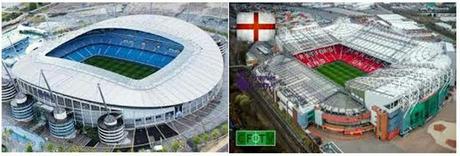
Terrace earthworks in Yunnan, China
Perhaps the most famous examples of terraces are those located insports stadiums especially in Britain and Ireland which comprise a series of concrete steps with safety barriers to prevent people from careering down the concrete slopes. Usually, the terraces were behind the goals in football stadiums where people could watch matches at a cheaper cost rather than the more expensive seats along the sides of the football pitch. One club whose terraces went along the side of the pitch was Manchester City’s Maine Road ground with the Kippax Street stand being the terrace where the home supporters gathered.Terraces were very popular in football grounds in Britain from the 1920s to the 1980s especially with the working class who created the songs and chants which created the atmosphere in the football grounds. However, the terraces also meant that more people could be packed into the ground and thereby make the home club more money.
Unfortunately, there were a number of issues, such as football hooliganism, where gangs would try to take the ‘home end’ which resulted in crowd violence in stadiums and surrounding streets especially during the 1970s and 1980s. As a consequence, football terraces were segregated and divided into pens. The end of terraces came with the Hillsborough disaster in Sheffield in April 1989 where 97 Liverpool fans died during the FA Cup semi-final between Liverpool and Nottingham Forest. This was the highest death toll in British sports history.
The police tried to blame Liverpool fans for the disaster. However, the Taylor Report into the disaster blamed the police and the stadium design with crash barriers hindering fans not helping them. Taylor commented that standing was not “intrinsically unsafe” but believed that all major stadiums in England should now be all-seater venues.
Taylor said that football clubs should not use the excuse of all seater stadia to drive up prices. The Taylor report commented that clubs should do their best to retain their working-class roots and let people of all ages and backgrounds be able to attend games. This plea was forgotten with the advent of the Premier League and Sky television as a new world of football emerged.

Images of Manchester City and Manchester United football stadia
Football grounds in the Premier League are totally different now as they are all seated and private/corporate boxes proliferate as does the cost to hire them for matches. Premier League clubs are awash with television money and can sign players from all over the world paying many of them hundreds of thousands of pounds a week. Many grounds seem to have lost their “atmosphere” on a match day/night. Roy Keane, in a famous/infamous rant, blamed the corporate fans for the lack of atmosphere claiming many were only at the match for the prawn sandwiches and beer.Another change from the days of the terraces in the Premier League/Sky/satellite television era are the sheer number of games that can be watched at any time. It is now possible to watch a football match all day every day viewing teams you have never heard of in leagues you never knew existed in countries and continents all over the world.The terraces are long gone though there are attempts to get some safe standing areas in football grounds but whether these will increase or create a better atmosphere during matches remains to be seen. One thing seems certain, there will not be a return to the old-style terraces of the pre-Hillsborough era, which may not be a bad thing.Thanks for reading and I will leave you with Mitchell and Webb’s take on Sky’s football coverage which, since this clip was first aired, has only increased. Have fun, DM.F A Cup 3rd Round
It’s 3 o’clock. Saturday. The
teams are out, the crowd scream,
shout, hurl insults all about,
songs burst into the frenzied fray.
Excitement, fear surge around the
ground, the terraces shove,
rush, push to the front and
back, swaying, braying into
mad chanting, ranting at the
referee. Dubious decisions meet
with derision, players protest,
tackles are brutal, grotesque,
everyone gets up with hardly a
rest and hobble on with the
quest. Another goal! Just
one more, then it’s praying,
praying for victory, for history
at the final score. Fans file
into the streets, singing
ringing in victorious ears.
D Moroney 2023
Email ThisBlogThis!Share to TwitterShare to Facebook
